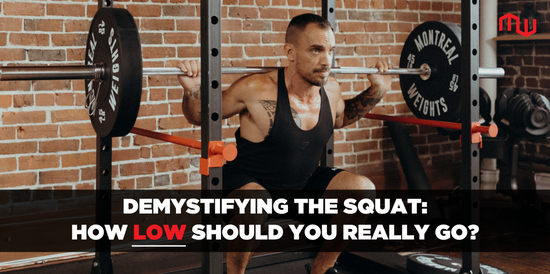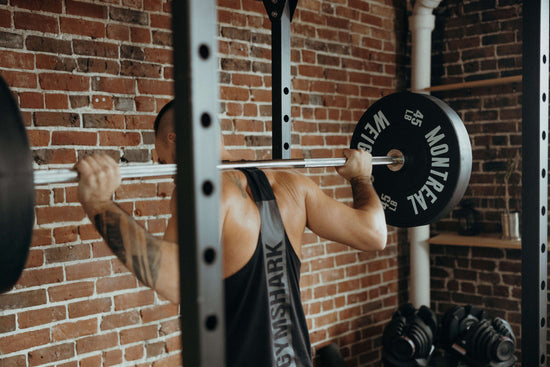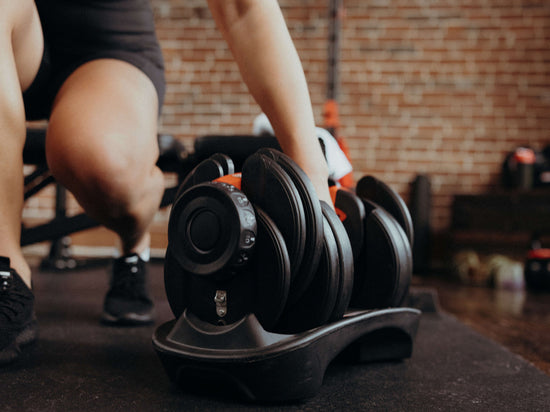Dumbbell squats are one of the most popular exercises among fitness beginners and expert trainers. It’s a simple exercise, yet can work wonders on multiple muscle groups in the body. It’s also perfect for your at-home workouts because it requires minimal equipment—just a set of dumbbells. So, are dumbbells the right addition to your squat? Let’s discuss.
How To Squat With Dumbbells
Is Squatting With Dumbbells Effective?
Yes, the dumbbell squat is very effective. Dumbbells add weight to your workout that pushes your body to exert more force in order to maintain the correct form and perform the repetition. In comparison to other exercises like the barbell squat that work the entire body, the dumbbell squat directly targets specific muscles, depending on the variation. Dumbbell squats also effectively improve stability, balance, posture, and power.
Can You Build Muscle With Dumbbell Squats?
Dumbbell squats are a great exercise for building muscle. A weighted squat is one of the most common lower body exercises in an exercise program because of the many muscle groups that it targets throughout the entire body.
Muscles Worked With Dumbbell Squats
The dumbbell squat is a compound exercise that works multiple muscles, including your lower body and core. The primary muscles worked with dumbbell squats include the gluteus maximus (glutes), quadriceps (quads), and stabilizing muscles around the hips, calves, knees, and ankles for improved balance.

How Heavy Should Dumbbells Be for Squats?
The weight load that you use for your squat depends completely on your body. The trick here is to gradually increase the weight slowly and comfortably over time—a strategy called progressive overload. This strategy is important to implement in all of your strength training workouts because it allows your body to adapt and grow its muscle naturally.If you’re a complete beginner introducing weights into your squat, start off low with a 5-10 lb dumbbell. As your muscles strengthen, slowly increase the weight load by about 5-10 lbs once you find your current rep range easy to complete. Make sure that you are able to perform the same amount of reps as with the previous weight while maintaining the proper squat form. If not, return back to the original weight.
Correct Form for Squatting With Dumbbells
The standard dumbbell squat is the same as bodyweight squats but with a dumbbell held on each side of the body. The correct form for a standard dumbbell squat is as follows:
Hold two dumbbells in both hands, hanging comfortably on each side of the hips.
Place your feet shoulder width apart and toes pointing straight forward.
Throughout the entire repetition, keep your back and head straight, core engaged and knees above the toes. Keep your feet flat on the floor with your weight evenly distributed along each entire foot.
Sit back, lowering your hips until your thighs are parallel to the floor. Make sure your knees don’t fall forward past the toes.
Hold for 1-2 seconds in this position, then slowly return to the starting position.
Repeat
Dumbbell Squat Variations
There are multiple variations of the dumbbell squat. Slight adjustments in form change your center of gravity, targeting different muscles or increasing the intensity of your workout.
How to Do Goblet Squats With Dumbbells
The placement of the dumbbell in a goblet squat works additional muscles in the upper body and back, including the shoulders, forearms, lats and grip strength. The goblet squat shifts the center of gravity forward which increases the resistance on your glutes. It also increases core strength because when a weight is held above the waist, the load of the weight pulls your chest forward. As a result, throughout the range of motion, your body needs to work harder to maintain good form of the spine.
- Use the palms of your hands to hold the dumbbell vertically against your chest.
- Place your feet shoulder width apart, back straight, toes forward and eyes looking straight ahead.
- While engaging your core, sit your hips downward until your thighs are parallel to the floor.
- Pause for a few seconds and slowly return to the standing position.
- Repeat
How to Do Sumo Squats With Dumbbells
The sumo squat variation targets the adductors located in the inner thigh more than the traditional dumbbell squat. The adductors increase hip mobility and balance.
There are a few variations of how you can hold the dumbbell in a sumo squat:
Hold a dumbbell vertically in both hands against your chest, the same way you would for a goblet squat. This variation, like the goblet squat, increases resistance on the core.
Hold 1 or 2 dumbbells in front of your body, with your arms straight down. As you squat down, the dumbbell will go between your two legs. This variation shifts the center of gravity forward, thus increasing intensity on the glutes.
Sumo Squat Proper Form:
With your dumbbells in hand, assume a wide stance with your feet more than hip width apart and your feet facing slightly outward.
Keeping your spine straight and core tight, slowly lower into your squat until your thighs are parallel to the floor. Be sure that your knees don’t fall forward past your toes.
Return to the standing position and repeat.
How to Do Split Squats With Dumbbells
The dumbbell split squat directly targets the quads. As a single-leg exercise, this dumbbell squat shifts the weight all onto one leg.
Move your body weight onto one foot. This will be your front foot and will feel the most intensity.
Place your other foot comfortably behind you, touching only the toe to the ground.
Holding 2 dumbbells comfortably to each side, slowly lower your hips until your front thigh is parallel to the floor. Your back leg below the knee should also be parallel to the ground at a 90 degree angle. If it isn’t, adjust your back foot at the end of your first repetition.
Keep your core tight, back and neck straight, knees above your toes, and front foot flat on the ground throughout the entire repetition.
Slowly return to the standing position.
Repeat on both legs.
How to Do Bulgarian Split Squats
The Bulgarian split squat increases the mobility in your hips and works the quads and glutes by elevating your back foot.
Stand 2-3 feet in front of a chair, bench, or step that is no higher than the knees.
Place the top of one foot onto the bench with the other foot a few feet in front of you. Hold 1 dumbbell in each hand comfortably by each side.
Keeping your core tight and spine straight, slowly lower your back knee until your front thigh is parallel to the floor.
If you lean slightly forward, you’ll feel this more in your glute. If your back is straight, you’ll feel it in your quad. You may need to adjust your foot positioning to feel the burn appropriately.
Pause for a few seconds and push off your front leg to return to the starting position.
Repeat on both legs.
Other Dumbbell Squat Variations
The following are a few other variations of the dumbbell squat to target different muscles in the body:
Grab 2 dumbbells, and hold them up close to your chest with your elbows pointing forward and arms parallel to the floor. This position increases resistance on the upper body muscles and lower back, increasing postural stability.
Hold the dumbbell weights overhead, being sure to keep your elbows slightly bent. This dumbbell placement targets the upper back muscles, especially the shoulders.
Hold two dumbbells in both hands, hanging comfortably on each side of the hips.
Place your feet shoulder width apart and toes pointing straight forward.
Throughout the entire repetition, keep your back and head straight, core engaged and knees above the toes. Keep your feet flat on the floor with your weight evenly distributed along each entire foot.
Sit back, lowering your hips until your thighs are parallel to the floor. Make sure your knees don’t fall forward past the toes.
Hold for 1-2 seconds in this position, then slowly return to the starting position.
Repeat
Dumbbell Squat Variations
There are multiple variations of the dumbbell squat. Slight adjustments in form change your center of gravity, targeting different muscles or increasing the intensity of your workout.
How to Do Goblet Squats With Dumbbells
The placement of the dumbbell in a goblet squat works additional muscles in the upper body and back, including the shoulders, forearms, lats and grip strength. The goblet squat shifts the center of gravity forward which increases the resistance on your glutes. It also increases core strength because when a weight is held above the waist, the load of the weight pulls your chest forward. As a result, throughout the range of motion, your body needs to work harder to maintain good form of the spine.
Use the palms of your hands to hold the dumbbell vertically against your chest.
Place your feet shoulder width apart, back straight, toes forward and eyes looking straight ahead.
While engaging your core, sit your hips downward until your thighs are parallel to the floor.
Pause for a few seconds and slowly return to the standing position.
Repeat
How to Do Sumo Squats With Dumbbells
The sumo squat variation targets the adductors located in the inner thigh more than the traditional dumbbell squat. The adductors increase hip mobility and balance.
There are a few variations of how you can hold the dumbbell in a sumo squat:
Hold a dumbbell vertically in both hands against your chest, the same way you would for a goblet squat. This variation, like the goblet squat, increases resistance on the core.
Hold 1 or 2 dumbbells in front of your body, with your arms straight down. As you squat down, the dumbbell will go between your two legs. This variation shifts the center of gravity forward, thus increasing intensity on the glutes.
Sumo Squat Proper Form:
With your dumbbells in hand, assume a wide stance with your feet more than hip width apart and your feet facing slightly outward.
Keeping your spine straight and core tight, slowly lower into your squat until your thighs are parallel to the floor. Be sure that your knees don’t fall forward past your toes.
Return to the standing position and repeat.
How to Do Split Squats With Dumbbells
The dumbbell split squat directly targets the quads. As a single-leg exercise, this dumbbell squat shifts the weight all onto one leg.
Move your body weight onto one foot. This will be your front foot and will feel the most intensity.
Place your other foot comfortably behind you, touching only the toe to the ground.
Holding 2 dumbbells comfortably to each side, slowly lower your hips until your front thigh is parallel to the floor. Your back leg below the knee should also be parallel to the ground at a 90 degree angle. If it isn’t, adjust your back foot at the end of your first repetition.
Keep your core tight, back and neck straight, knees above your toes, and front foot flat on the ground throughout the entire repetition.
Slowly return to the standing position.
Repeat on both legs.
How to Do Bulgarian Split Squats
The Bulgarian split squat increases the mobility in your hips and works the quads and glutes by elevating your back foot.
Stand 2-3 feet in front of a chair, bench, or step that is no higher than the knees.
Place the top of one foot onto the bench with the other foot a few feet in front of you. Hold 1 dumbbell in each hand comfortably by each side.
Keeping your core tight and spine straight, slowly lower your back knee until your front thigh is parallel to the floor.
If you lean slightly forward, you’ll feel this more in your glute. If your back is straight, you’ll feel it in your quad. You may need to adjust your foot positioning to feel the burn appropriately.
Pause for a few seconds and push off your front leg to return to the starting position.
Repeat on both legs.
Other Dumbbell Squat Variations
The following are a few other variations of the dumbbell squat to target different muscles in the body:
Grab 2 dumbbells, and hold them up close to your chest with your elbows pointing forward and arms parallel to the floor. This position increases resistance on the upper body muscles and lower back, increasing postural stability.
Hold the dumbbell weights overhead, being sure to keep your elbows slightly bent. This dumbbell placement targets the upper back muscles, especially the shoulders.
Common Dumbbell Squat Mistakes
- Heels lifting off the ground. When your heels come off the ground, you’re more likely to fall forward during your rep. It also makes your squat less effective because it reduces the amount of force transferring into the floor.
- Knees falling forward, or caving inward, or outward. Always keep your knees inline with your toes to maintain good form. Initiating your squat by sitting back and lowering your buttocks instead of by bending your knees is a helpful way to avoid this mistake.
- Rounding the back. This reduces the effectiveness of the squat because there is less resistance against the lower back muscles. Engage your core and keep your chest high.
- Looking down. This is an extension of rounding the back. The entire spine should be kept straight. If you want to evaluate your form, video record your workout instead.
Tips for a Safer and More Effective Dumbbell Squat
Along with avoiding the common mistakes of the dumbbell squat, you should also take the following precautionary measures to prevent injury.
-
Warm Up Prior to Your Workout
-
Warming up is important for every workout session. Warming up increases your blood temperature, which builds oxygen in the bloodstream. As more oxygen enters the bloodstream, endurance increases and activates the muscles to improve the efficiency of your exercise. More importantly, however, warm ups reduce injury because with increased oxygen in the bloodstream, muscles are more flexible and less likely to tear, rip, or twist in a harmful way during your workout.
-
Warming up is important for every workout session. Warming up increases your blood temperature, which builds oxygen in the bloodstream. As more oxygen enters the bloodstream, endurance increases and activates the muscles to improve the efficiency of your exercise. More importantly, however, warm ups reduce injury because with increased oxygen in the bloodstream, muscles are more flexible and less likely to tear, rip, or twist in a harmful way during your workout.
-
Dress Comfortably
-
Perfect the Bodyweight Squat Variation
- Incorrect form and posture can put strain on the wrong muscles. Consequently, incorporating weight into an incorrect squat increases the severity of the strain. Practice your bodyweight squats and ensure you have the right posture and form. Once you are confident in your form, you can slowly introduce heavier weights.
- Incorrect form and posture can put strain on the wrong muscles. Consequently, incorporating weight into an incorrect squat increases the severity of the strain. Practice your bodyweight squats and ensure you have the right posture and form. Once you are confident in your form, you can slowly introduce heavier weights.
-
Don’t Overwork Your Body
- If you start to feel discomfort in your hips or knees, don’t deepen the squat. Use that point of discomfort as the endpoint of your squat.
Also, make sure you progressively overload your weights instead of starting off with heavier weights than your body can handle. Rushing into weights that are too heavy can cause immense strain on your muscles, injury, and can cause your body to lose the proper form of your squat.
As such, use only a dumbbell weight that your body can handle at the time with perfect form and slowly increase the weight load as your muscles strengthen.
- If you start to feel discomfort in your hips or knees, don’t deepen the squat. Use that point of discomfort as the endpoint of your squat.
Master the Dumbbell Squat at Home With Montreal Weights
Congratulations, you’re now ready to crush your dumbbell squats! This exercise and its variations are essential to any strength training program to promote great muscle growth in the lower body. Be sure to always employ progressive overload and practice the correct form to get the most out of your exercise.
If you’ve mastered dumbbell squats and are looking for something a little more challenging, consider moving onto the barbell squat. Barbell squats target muscle groups throughout the entire body and give you the opportunity to increase resistance past the weight limitations of dumbbell squats.
Need dumbbells to add to your home gym? Try our adjustable dumbbells that will fit seamlessly into your exercise plan.





